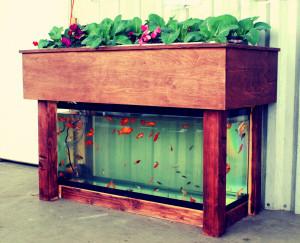
Cultivating Abundance: Exploring Indoor Aquaponics Systems
Indoor aquaponics systems have emerged as a fascinating and sustainable way to cultivate fresh produce while maintaining a compact and controlled environment. These systems integrate aquaculture and hydroponics, creating a symbiotic relationship between fish and plants. Let’s dive into the world of indoor aquaponics, exploring its benefits, components, and how it revolutionizes the way we approach home gardening.
The Harmony of Aquaponics: Understanding the Basics
At the heart of indoor aquaponics lies a harmonious collaboration between fish and plants. The fish produce nutrient-rich waste that becomes a natural fertilizer for the plants. In turn, the plants act as a natural filter, purifying the water before it returns to the fish tank. This closed-loop system creates a sustainable and self-sufficient ecosystem, requiring less water and chemical inputs compared to traditional gardening methods.
Components of an Indoor Aquaponics System: A Closer Look
Indoor aquaponics systems consist of several key components, each playing a vital role in the success of the ecosystem. The fish tank is the central hub where fish, typically species like tilapia or trout, thrive and produce nutrient-rich water. A grow bed, filled with a growing medium like gravel or clay pellets, hosts the plants. A water pump circulates the water between the fish tank and the grow bed, and a biofilter ensures that harmful substances are broken down, maintaining a healthy environment for both fish and plants.
If you’re intrigued by the idea of setting up your own indoor aquaponics system, consider visiting Indoor Aquaponics Systems. This platform provides insights, tips, and resources to help you get started on your aquaponics journey.
Space-Saving Marvel: Benefits of Indoor Aquaponics
One of the remarkable advantages of indoor aquaponics is its space efficiency. Unlike traditional gardens that require extensive outdoor space, indoor aquaponics systems can thrive in compact areas. This makes them ideal for urban dwellers or anyone with limited gardening space. The ability to cultivate a variety of vegetables, herbs, and even some fruits indoors brings the joy of gardening to urban settings.
Year-Round Harvest: Overcoming Seasonal Limitations
Indoor aquaponics systems offer the luxury of year-round cultivation, overcoming the limitations imposed by seasonal changes. By controlling factors like temperature and light, enthusiasts can create a stable and consistent environment for their aquaponic gardens. This ensures a continuous harvest, providing a fresh and homegrown supply of produce regardless of external weather conditions.
Environmental Sustainability: Reducing Water Usage and Waste
Compared to traditional gardening and farming methods, indoor aquaponics stands out as an environmentally sustainable choice. The closed-loop system significantly reduces water usage, as water is continuously recycled between the fish tank and the grow bed. Additionally, the reliance on natural fish waste as a fertilizer minimizes the need for synthetic fertilizers, contributing to a more eco-friendly and resource-efficient gardening approach.
Educational and Therapeutic Value: Engaging with Nature Indoors
Indoor aquaponics systems offer educational and therapeutic benefits, especially for households with children or individuals seeking a mindful and engaging hobby. Observing the symbiotic relationship between fish and plants provides valuable insights into ecosystems and sustainable living. Beyond the educational aspect, tending to an indoor aquaponics system can be a therapeutic and stress-relieving activity, connecting individuals with nature even in indoor settings.
Customization and Scalability: Tailoring Aquaponics to Your Needs
One of the exciting aspects of indoor aquaponics is its flexibility and scalability. Enthusiasts can customize their systems based on available space, desired produce, and personal preferences. Whether it’s a small countertop setup for fresh herbs or a larger system supporting a variety of vegetables, the scalability of indoor aquaponics makes it accessible to gardening enthusiasts with diverse needs.
Challenges and Considerations: Navigating Potential Hurdles
While indoor aquaponics brings many benefits, it’s essential to consider potential challenges. Monitoring water parameters, maintaining proper balance in the ecosystem, and addressing any issues promptly are crucial aspects of successful aquaponics. Additionally, choosing suitable fish species and understanding their specific requirements contribute to the overall health and sustainability of the system.
Community and Knowledge Sharing: Joining the Aquaponics Enthusiasts
The growing popularity of indoor aquaponics has led to the formation of a vibrant community of enthusiasts. Online forums, social media groups, and local clubs provide platforms for knowledge sharing, troubleshooting, and celebrating successes. Joining this community allows individuals to learn from experienced aquaponics practitioners, share their own insights, and be part of a collective journey toward sustainable and innovative gardening practices.
Conclusion: Cultivating a Greener Tomorrow, Indoors
In conclusion, indoor aquaponics systems represent a captivating fusion of aquaculture and hydroponics, bringing the joy of gardening into the heart of our homes. With benefits ranging from space efficiency and year-round harvests to environmental sustainability and therapeutic value, indoor aquaponics offers a holistic approach to home cultivation. Whether you’re a seasoned gardener or a novice exploring the world of indoor gardening, the allure of cultivating your own fresh produce in a self-sustaining ecosystem is a journey worth undertaking.
